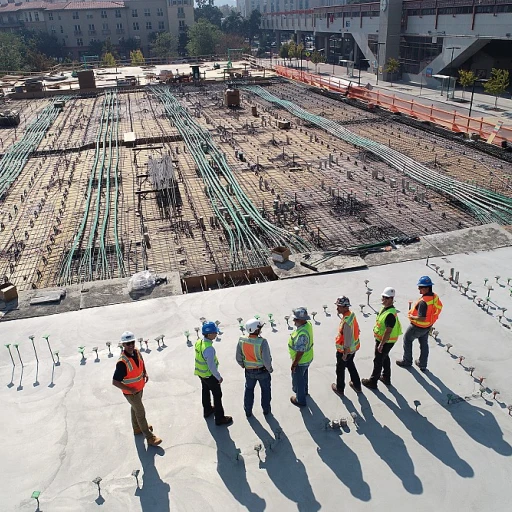
The Importance of Recruiters in Succession Planning
The Strategic Role of Recruiters in Implementing Succession Planning
Succession planning is a critical component for the sustained success of any organization. It's a process that ensures companies can fill key roles promptly with qualified candidates, maintaining operational continuity. Within this framework, recruiters play an integral part in facilitating this transition seamlessly. Their expertise in identifying and engaging potential candidates makes them invaluable assets in succession planning.
Incorporating the skills and experience of professional recruiters into the succession planning process allows businesses to maintain a sustainable edge in acquiring top talent. This activity is aligned with strategic HR functions such as talent acquisition and development, enabling hiring managers to redefine and enhance job descriptions tailored for future organizational needs. Recruiters, by leveraging their networks and resources, are pivotal in connecting organizations with prospective top talent, often via social media networks and industry-specific platforms.
Their understanding of the nuances in a recruiter job description empowers them to act effectively in cycles of recruitment. Whether they are cycle recruiters, technical recruiters, or senior recruiters, they hold unique insights into job requirements and candidate expectations. This broad knowledge base assists in matching candidates' skills with the company’s expectations, providing a clear pathway for nurturing future leaders.
Moreover, recruiters contribute significantly through their involvement in the full cycle recruitment. This includes understanding the prospective job and its requirements, crafting an engaging job description, and screening potential talent. Their candidacy vetting process ensures only the most qualified candidates reach the interview stage. Through detailed interview questions and assessments, they establish whether a candidate's prowess aligns with the long-term goals of the company.
For more insights on transitioning roles within succession frameworks, such as CEO and chairman roles, explore Navigating the Transition: CEO and Chairman Roles in Succession Planning.
Key Responsibilities of Recruiters
Key Duties and Responsibilities of Recruiters in Succession Planning
Recruiters play a pivotal role in succession planning by managing key responsibilities essential for the effective identification and placement of potential candidates within a company. These duties require a wide array of skills to ensure every aspect of the recruitment cycle is thoroughly handled, from initial job descriptions to final hiring decisions.
Among their primary responsibilities, recruiters must:
- Develop Job Descriptions: Craft precise job requirements and descriptions to attract top talent, ensuring these documents align with the company's long-term goals and future key roles.
- Talent Acquisition: Use various methodologies and platforms, including social media, to acquire qualified candidates who align with both the senior recruiter and the strategic recruiting plan.
- Collaborate with Hiring Managers: Actively engage with hiring managers to ensure the recruitment process aligns with organizational objectives and meets company culture requirements.
- Screen Potential Candidates: Utilize interview questions and assessment tools to identify candidates with the right skills and experience.
- Manage the Recruitment Process: Oversee the full cycle of recruiting, ensuring the hiring process runs smoothly from start to finish.
- Utilize Technical Tools: Leverage technology and platforms to streamline recruiting efforts and resource management.
Recruiters must possess an adept understanding of human resources principles and the nuances of the recruiting process to fill roles efficiently. Their role requires balancing technical skills with a human-centric approach to effectively predict which candidates will transition to leadership positions within the company.
Understanding the differences in roles within succession planning can further enhance the recruiters' effectiveness, as highlighted in this analysis of strategic roles involved in succession planning.
Challenges Faced by Recruiters
Overcoming the Hurdles in Talent Acquisition
The journey of succession planning places recruiters in a pivotal role, yet it's fraught with challenges. Identifying and overcoming these hurdles is essential for seamless talent acquisition and placement. Let's delve into some of the common obstacles recruiters encounter and possible strategies to tackle them.
First and foremost, job market competitiveness is a significant barrier. With numerous companies competing for the top talent, recruiters often face pressure to fill roles quickly without compromising on the skills and experience needed. This challenge underscores the importance of crafting a precise job description and using an effective recruitment process.
Furthermore, even the most seasoned recruiters encounter difficulties in balancing the expectations of hiring managers with the realities of the available talent pool. There’s often a mismatch between job requirements and candidate capabilities. A comprehensive strategy includes creating a realistic job description template and aligning it with clear interview questions to gauge potential effectively.
Moreover, the technological aspect of recruiting, like utilizing speculative social media platforms and recruiting tools to reach potential candidates, requires continuous learning and adaptation. Recruiters must balance technological advances with human connections to assess candidates’ compatibility with the company culture.
Other pressing challenges include managing resource allocations, especially for small HR teams. A well-outlined path within a recruiter job could involve innovative resource management and a streamlined hiring process aimed at minimizing cost and maximizing output through technology use.
Finally, navigating the intricacies of full cycle recruiter responsibilities encompasses strategic candidate engagement. From identifying qualified candidates to ensuring they fit into the long-term goals of the company, recruiters are tasked with a profound responsibility that can impact the overall strength of the organization.
Addressing these challenges doesn’t come without assistance. By understanding and leveraging a detailed plan for succession, recruiters can ensure a smooth and effective process in their critical roles. For a deeper insight into this aspect of core responsibilities, these scenarios are important benchmarks for success.
Strategies for Effective Succession Planning
Strategizing for Success in Succession Planning
Effective succession planning is a multifaceted process that requires meticulous strategies. Recruiters play a central role in this process, ensuring the alignment of potential candidates with a company's long-term goals. Here’s how they can craft effective succession strategies:- Aligning Talent with Future Needs: The initial step involves understanding the company’s future direction and job requirements. Recruiters must meticulously tailor the job description to attract candidates who not only fit the current role but possess the skills and experience likely to evolve with the company’s needs. Identifying top talent within the organization or externally who can be groomed for future leadership positions is crucial.
- Collaborative Approach: Building a strong relationship with hiring managers and human resources is key. This collaboration ensures that the recruitment process identifies the right candidates who align with not only the job requirements but also the company culture. It facilitates the flow of feedback and refinement of the recruitment process to better meet the company objectives.
- Continuous Development: An ongoing recruitment cycle is essential for succession planning. Recruiters should work closely with company leadership to ensure continuous skill development and readiness of the talent pool. This includes creating robust training programs and identifying development opportunities to prepare potential successors.
- Utilizing Social Media and Technology: Leveraging tools and technologies is vital for reaching a broader pool of qualified candidates. Social media platforms and recruiting software enable recruiters to effectively post job openings and fill critical positions with ease. Additionally, advanced talent acquisition systems can streamline the hiring process and enhance the efficiency of identifying top talent.
- Feedback and Improvement: Harvesting insights from recruitment cycles enables recruiters to refine strategies continually. This feedback loop is essential for staying aligned with industry standards and company expectations, ensuring that the process is improved and remains effective in the long term.
Tools and Technologies for Recruiters
Leveraging Technology for Efficient Recruitment
In the realm of succession planning, recruiters play a pivotal role in ensuring that the right talent is identified and nurtured for future leadership roles. To achieve this, leveraging the right tools and technologies is crucial. These resources not only streamline the recruitment process but also enhance the ability to identify and engage top talent effectively.
Applicant Tracking Systems (ATS)
Applicant Tracking Systems are indispensable for recruiters. These systems help manage the full cycle of recruitment by organizing job applications and tracking candidates throughout the hiring process. An ATS can automate the posting of job descriptions, filter resumes based on job requirements, and schedule interviews, thereby saving time and resources.
Social Media and Networking Platforms
Social media has become a powerful tool for recruiters to connect with potential candidates. Platforms like LinkedIn allow recruiters to search for candidates with specific skills and experience, making it easier to fill roles with qualified candidates. Engaging with talent on these platforms also helps build a strong employer brand, which is essential for attracting top talent.
Data Analytics and AI
Data analytics and artificial intelligence are transforming the recruitment landscape. These technologies enable recruiters to analyze large volumes of data to identify patterns and trends in candidate behavior. AI can also assist in crafting effective job descriptions and interview questions, ensuring that the recruitment process is aligned with the company's strategic goals.
Collaboration Tools
Effective succession planning requires collaboration between recruiters, hiring managers, and other stakeholders. Tools that facilitate communication and collaboration, such as project management software and communication platforms, are essential. These tools ensure that everyone involved in the recruitment process is on the same page, thereby enhancing the efficiency of talent acquisition.
By integrating these tools and technologies, recruiters can enhance their capabilities and contribute significantly to the company's succession planning efforts. This not only ensures that the organization is prepared for future leadership transitions but also strengthens its overall talent acquisition strategy.
Case Studies of Successful Succession Planning
Examples of Successful Succession Planning in Practice
Succession planning is an intricate process, blending the expertise of recruiters with strategic foresight. There are multiple dimensions to how a company can succeed in this regard. Here, we'll explore some case studies highlighting effective recruitment and succession methodologies and how they can serve as blueprints for organizations aiming to secure top talent and leadership continuity.
One company implemented a robust succession plan by prioritizing internal talent development. Their recruiters worked alongside human resources and hiring managers to identify high-potential candidates within the organization and create personalized development plans. This approach, ensuring a pool of qualified candidates ready to step into leadership roles, significantly reduced the time and resources necessary for external recruitment.
In another scenario, a global firm leveraged technology and social media to enhance their succession planning. By adopting advanced tools and platforms, their recruiters effectively mapped out the skills and experiences of potential candidates, streamlining the recruitment process. Additionally, these digital resources facilitated better collaboration between the recruitment team and other departments, resulting in seamless talent acquisition and improved retention rates.
Next, let’s consider a company that utilized a full cycle recruitment approach while focusing on developing a comprehensive job description template. This strategy allowed recruiters to clearly outline the responsibilities and job requirements for each role, ensuring more accurate matches between candidates and positions. The result? A hiring process that not only filled roles efficiently but also enhanced the overall team dynamics through well-matched talent placements.
These real-world examples underscore the critical role recruiters play in effective succession planning. By understanding key responsibilities, overcoming challenges, and utilizing innovative tools, organizations can secure their future leadership pipeline and maintain a competitive edge.












